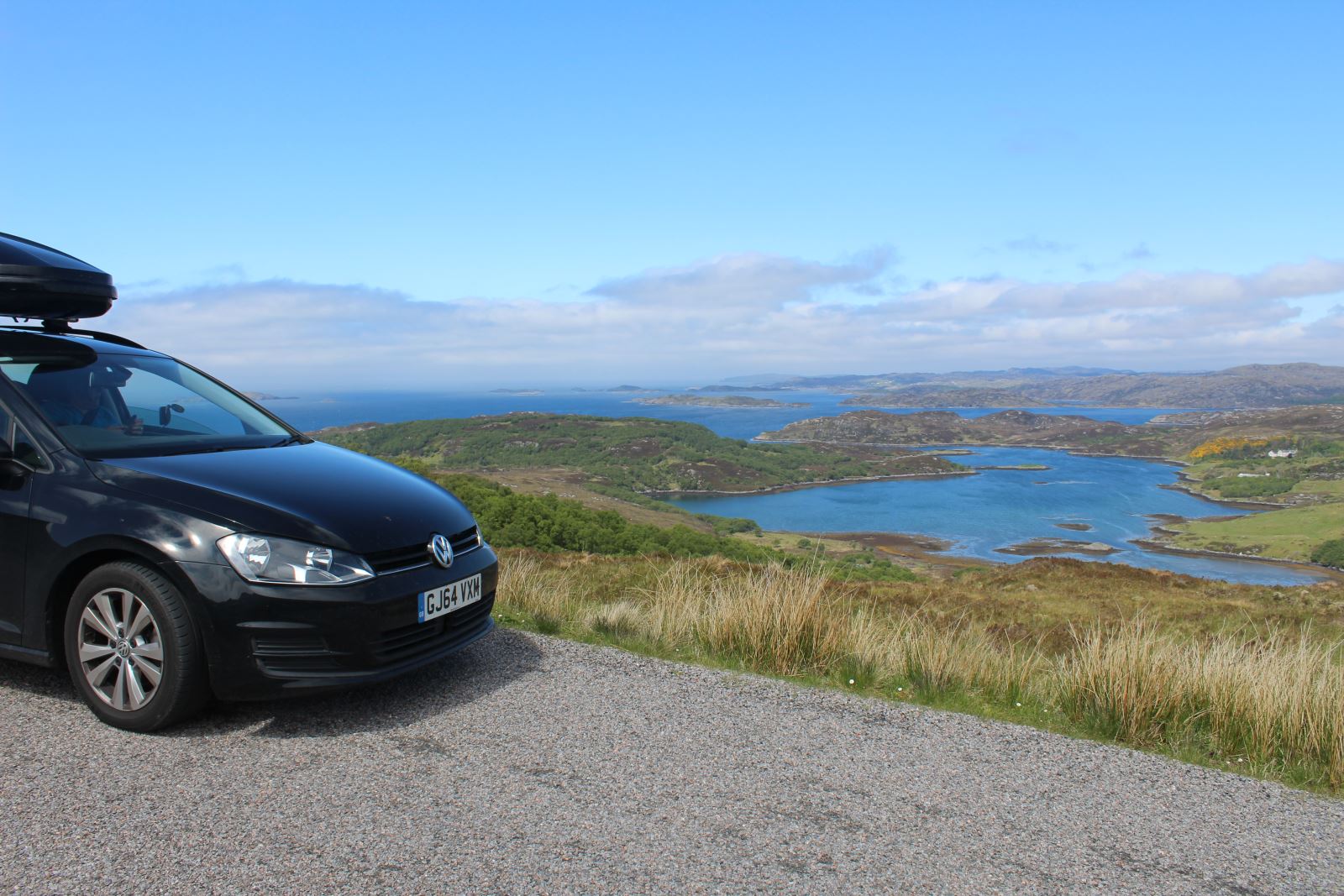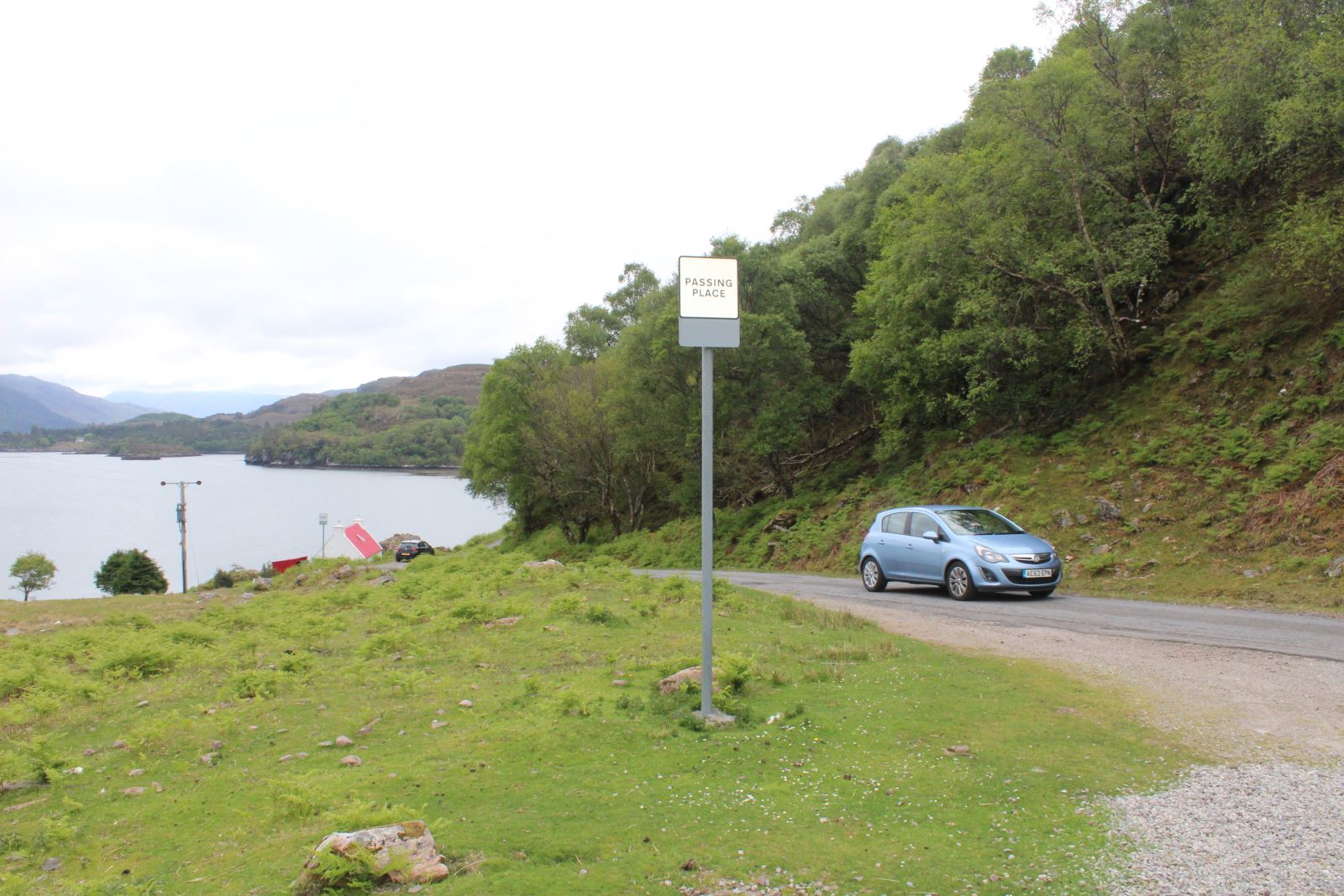Camping the North Coast 500: safe driving advice
The North Coast 500 is one of the most beautiful coastal routes in the word. As a result it is extremely popular tourist attraction, attracting hundreds of thousands of visitors from all over the world every year.
At peak times, in the summer months especially, the North Coast 500 can be very busy. In addition, many of the drivers who use the route are unaccustomed to negotiating the narrow, winding roads you will find in this part of the country.
Remember that as well as tourists, you will be sharing the roads with local people who rely on the roads for their day-to-day life. So it is important to make sure you drive responsibly and safely and treat the area with respect.
If you are towing a caravan, or have a large motorhome or campervan (more than around 18ft in length), you should not use the main North Coast 500 route – take the alternative motorhome routes instead. In particular, do not attempt to drive the Bealach Na Ba or B869 Drumbeg Road stretches.
Long stretches of the North Coast 500 are on single-track roads and these require certain skills to negotiate. Here’s some top tips for safe driving on the single-track roads of the NC500
# Look out for hazards
Single track roads tend to be windy as well as narrow, so you never know what might be coming round a corner.
Look out for hidden dips, blind summits and concealed entrances and be aware that overgrown hedges and trees could potentially obscure your view.
Stay alert the whole time and work on the assumption that another vehicle could be literally round the corner. And don’t be distracted by the scenery.
# Watch your speed
Tempting as it is to put the foot down on these quiet, winding roads, driving too fast means you might not be able to stop in time, especially if the other vehicle coming towards you is going to fast too.
# Be aware of other road users
It’s not just cars, vans and lorries you have to worry about. Cyclists, pedestrians and horse riders all use roads like these and deserve special attention.
Pass wide and slow and give them as much room as you can – at least 1.5m is the latest guidance from the Highway Code.
Because you will be driving through farmland, a lot of which doesn’t have fencing, there’s a good chance you’ll encounter sheep, cattle or wildlife at some point on your travels. If you have to, just stop and let them pass.
# Be ready to reverse
If you reach a stand-off with another vehicle, something’s got to give and this means one of you reversing to the nearest passing place.
Usually the person closest to a passing place makes the move. If you are not comfortable with reversing for relatively long distances, don’t use the route.
# Time it right
Adjust your speed so you meet other cars at a passing place without either of you having to stop.
# Be assertive
We’re certainly not suggesting you should be aggressive, but if you are too timid on these single-track roads then you could end up being stuck for ages letting cars through. And if there are other cars behind you, that will not make you popular.
# Keep to the left
Driving towards the left side of the road is the best way to avoid a head on collision. Also, if the passing place is on the right, stop on the left of the road rather than pulling across to the other side of the road.
# Do NOT park in passing places
It doesn’t matter how amazing the view is or how desperate you are for a wee, stopping in a passing place or a field entrance is not something you should be doing.
# Look behind you
Keep an eye on your mirrors and if you notice someone coming up fast behind you, try to let them past at the next passing place.
# Keep calm
Driving on single track roads can be stressful if you let it, but if you stay relaxed, concentrate and think ahead, you should be fine. And if you get stuck behind a slow moving caravan or tractor, just chill out and enjoy the ride.
Finished reading?
Want more great information about the North Coast 500? Our guide to Britain's favourite road trip is full of great information and camping advice.
Expert camping advice to your door!
Camping magazine has been the voice of campers for over 60 years!
It is the only magazine in the UK dedicated to the wonderful world of tents and life under canvas. Every issue features travel ideas in the UK and further afield, as well as top sites to stay on, plus tent and gear tests to ensure you are properly equipped for all your camping adventures!
Why not treat yourself to a subscription today?
Don't go camping without it!










Recent Updates
Camping barbecue: our guide to cooking up a storm this summer
Is there anything more British than sausages grilled on an open flame and dropped on wet grass? Camping and barbecues go hand in hand, which is why ...
Our family camping checklist: everything you need to pack
Sure, you’ve packed the tent and the sleeping bags – but what about slip-on shoes and glow sticks? These are ...
Our guide to planning the perfect camping road trip
Roll down the window, pop on those shades and crank up the volume – it’s time for a road trip. Get ready for ...
Camping in Europe: our 12 top tips
If you’ve not camped in Europe before, there’s a few tips and tricks you’ll need to avoid some continental ...
Solar power for camping: all you need to know
Staying connected in the great outdoors is easier than ever with a solar charger – or is it? How reliable are ...
Wild camping kit list: everything you need for your next adventure
Make sure you’re ready for anything with this list of lightweight camping gear and clothing, including ...
Camping furniture: all you need to know to make your tent a cosy haven
We delve into the essentials of camping chairs, camping tables, and kitchen and bedroom furniture, ensuring ...
Camping lights for tents: What you need to know
We will guide you through all the lighting options available for you and your tent, including interior ...
Camping kitchen: all you need to know
In the great outdoors, a well-equipped camping kitchen transforms mealtime into a delightful adventure ...
How to pack away your camping gear for winter
A complete guide to packing and storing your gear at the end of the season ...
Other Articles
Camping guide to trailers
Trailer stash or trailer trash? Being able to carry lots of other gear when you go camping isn’t such a bad idea, is it? Nick Harding looks at the ...
Winter camping: all you need to know to keep warm
Winter doesn’t have to mean the end of the camping season. With good preparation and the right gear, there’s ...
Camping toilets: a complete guide
If you are wild camping, camping off-grid or the campsite you book onto doesn’t have toilet facilities, you ...
Top tips for camping in windy weather
How to make sure your tent stands up to gusty conditions ...
Camping tents: a complete guide
If you're considering buying a camping tent, whether it's your first time or you're a seasoned camper, making ...
Camping sleeping bags and beds: a complete guide
When it comes to camping, there's one essential item that can make or break your outdoor adventure: the ...
Camping gas: how to use gas on the campsite
A complete guide to using camping gas appliances safely on the campsite, from choosing the right stove to ...
Camping storage: a complete guide
Having problems knowing where to put all your gear when you're camping? Read our top tips and see some great ...
Camping electric hook-up: a complete guide
This is everything you need to know about using electricity on a campsite, including how to hook up ...
How to pack all your camping gear into your car
Planning a family camping holiday? Find out the best way to fit all the kit you need into your car boot, roof ...